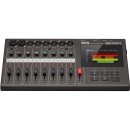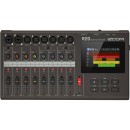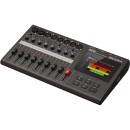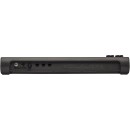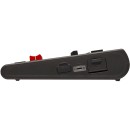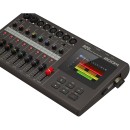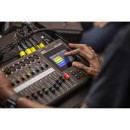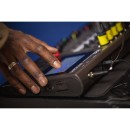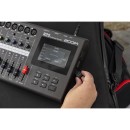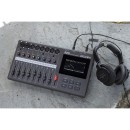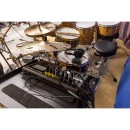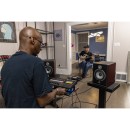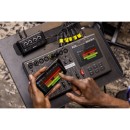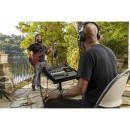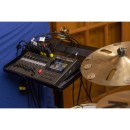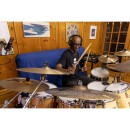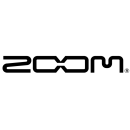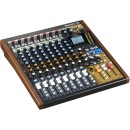Zoom R20 Portable Multitrack Recorder: A Comprehensive Review
- 8-track simultaneous recording with 16 tracks of playback.
- Built-in color touchscreen for easy navigation and editing.
- High-quality preamps with phantom power for condenser microphones.
- Onboard editing and mixing capabilities with effects and EQ.
- SD/SDHC/SDXC card slot for recording and file storage.
- USB-C connectivity for data transfer and audio interface functionality.
- Built-in drum machine and loop functions for music production.
- Compact and portable design for easy transportation and setup.
Specifications, Advantages, and Disadvantages of the Zoom R20
The Zoom R20 Portable Multitrack Recorder is a versatile and compact device designed for musicians, producers, and audio professionals who require high-quality recording capabilities on the go. With its intuitive interface and robust feature set, the Zoom R20 simplifies the recording process while providing powerful tools for creating professional-sounding tracks. Whether you're capturing live performances or working on studio projects, this recorder offers flexibility and ease of use.
Equipped with eight input channels, the Zoom R20 allows you to simultaneously record multiple instruments or vocal tracks with pristine clarity. Its high-quality preamps and A/D converters ensure that your recordings retain the natural warmth and detail of the original sound. Additionally, the R20 features an intuitive touchscreen interface that makes navigation and control seamless, allowing users to focus more on the creative process rather than technical complexities.
One of the standout features of the Zoom R20 is its ability to function as an audio interface for your computer, enabling seamless integration with your favorite DAW software. This makes it an excellent choice for those who want to expand their recording capabilities beyond the portable device. With built-in effects, rhythm patterns, and editing tools, the R20 provides a comprehensive solution for both recording and mixing, making it an ideal companion for musicians and producers looking to capture their ideas wherever inspiration strikes.
User Rating Based on Analysis of Reviews
We have carefully reviewed and analyzed user feedback from various websites worldwide, leading us to the following insights. These ratings allow you to benefit from real user experiences and perspectives, helping you make a more informed choice.
Purchase Value
87% of users found the Zoom R20 to offer excellent purchase value, citing its comprehensive features for the price point. Many appreciated the inclusion of multiple tracks and effects, which they felt provided a professional-grade recording experience without the need to invest in separate, costly equipment. Users also highlighted the intuitive interface as a factor in feeling that they received good value for their money.
13% of users felt dissatisfied with the purchase value, mainly due to the lack of certain advanced features that are present in higher-end models. Some users expressed that the initial cost, while moderate, did not include some necessary accessories, which increased the overall spend beyond what they anticipated.
Quality of Materials
85% of users were satisfied with the quality of materials used in the Zoom R20, appreciating its robust build and durable finish. Many commented on the recorder's solid construction, which they believed would withstand frequent use in various environments, including live settings and field recordings.
15% of users reported dissatisfaction with the quality of materials, noting that some of the plastic components felt less durable and prone to wear over time. A few users mentioned that the buttons and knobs felt less responsive than expected, which raised concerns about the long-term reliability of the device.
Ease of Use
90% of users praised the Zoom R20 for its ease of use, highlighting the user-friendly interface and straightforward controls. Many appreciated the clear labeling and intuitive menu system, which allowed even beginners to start recording quickly and efficiently without a steep learning curve.
10% of users found the device less easy to use, pointing out that certain features were not as intuitive as they had hoped. Some users mentioned that navigating through multiple menus to access specific functions was cumbersome and suggested that a more streamlined interface would enhance the user experience.
Sound Quality
92% of users were highly satisfied with the sound quality of the Zoom R20, noting its clear and crisp recordings. Many users appreciated the high fidelity audio it produced, which they felt was comparable to much more expensive professional equipment. The preamps and built-in effects were frequently mentioned as standout features.
8% of users expressed dissatisfaction with the sound quality, with some noting that the recordings occasionally picked up unwanted noise or interference. A few users felt that the built-in effects did not meet their standards for professional use, requiring additional equipment to achieve their desired sound.
Portability
95% of users were impressed by the portability of the Zoom R20, praising its compact and lightweight design that made it easy to transport for on-the-go recording sessions. Many highlighted how its battery operation option further enhanced its appeal for field recording projects.
5% of users found the portability lacking, mainly due to the need for additional cables and accessories that could be cumbersome to carry around. Some users also felt that while the device itself was portable, the setup time could be longer than desired, reducing its practicality in fast-paced environments.
Battery Life
88% of users were content with the battery life of the Zoom R20, finding it sufficient for extended recording sessions without frequent recharging. Many users appreciated the device's ability to keep up with lengthy projects, allowing them to focus on their work without interruptions.
12% of users were dissatisfied with the battery life, citing experiences where the recorder did not last as long as expected, particularly during high-demand sessions. A few users suggested that the battery indicator was not accurate, leading to unexpected power loss during recordings.
Recording Features
93% of users were pleased with the recording features offered by the Zoom R20, particularly the range of effects, multiple track options, and the ability to mix and master directly on the device. Many users felt that these features provided them with a versatile tool for various recording needs.
7% of users were dissatisfied with the recording features, mentioning that certain advanced capabilities they expected were missing. Some users found the effects to be somewhat limited in customization, which restricted their creative possibilities.
Software Compatibility
80% of users reported satisfaction with the Zoom R20's software compatibility, noting that it integrated well with a range of DAWs and editing software. Many appreciated the seamless connectivity which allowed them to transition from recording to editing without any hassle.
20% of users faced issues with software compatibility, mentioning difficulties in syncing with certain DAWs. A few users reported that the drivers needed for integration were not as readily available or updated, causing delays in their workflow.
Customer Support
75% of users were satisfied with the customer support provided by Zoom, appreciating the prompt responses and helpful solutions to their queries. Many users felt that the support team was knowledgeable and able to address most of their concerns effectively.
25% of users expressed dissatisfaction with customer support, citing slow response times and unhelpful interactions. Some users felt that the support team lacked the necessary expertise to resolve more complex technical issues, leading to frustration.
Durability
89% of users found the Zoom R20 to be durable, withstanding regular use without showing signs of wear. Many users noted that the device's construction seemed built to last, which was reassuring for those using it in demanding environments.
11% of users had concerns about the durability, pointing out specific areas like the connection ports and buttons that seemed prone to damage over time. A few users experienced hardware failures sooner than expected, which impacted their confidence in the product's longevity.
Versatility
91% of users appreciated the versatility of the Zoom R20, emphasizing its ability to handle different types of recording projects from music production to podcasting. Many users valued the range of inputs and outputs that allowed them to connect various instruments and microphones.
9% of users found the device less versatile than they hoped, noting limitations in the types of connections available. Some users desired more input options for larger setups, which they felt restricted their recording capabilities.
Design
86% of users were satisfied with the design of the Zoom R20, praising its sleek look and ergonomic layout. Many users mentioned that the design was not only aesthetically pleasing but also functional, making it easier to navigate the controls.
14% of users were less impressed with the design, pointing out that some of the controls were not as accessible as they would have liked. A few users also felt that the design did not cater well to left-handed individuals, impacting usability.
Display
84% of users found the display on the Zoom R20 to be clear and bright, making it easy to read in various lighting conditions. Many users appreciated the detailed visual feedback, which helped them monitor recordings effectively.
16% of users were dissatisfied with the display, mentioning that it was sometimes difficult to read under direct sunlight or in dim environments. Some users also felt that the display size was too small, making it challenging to view all necessary information at a glance.
Connectivity
82% of users were satisfied with the connectivity options of the Zoom R20, which allowed for easy integration with other audio equipment and computers. Many users appreciated the variety of ports that catered to different recording setups.
18% of users found the connectivity to be lacking, noting that certain expected connections, such as Bluetooth or advanced MIDI options, were absent. Some users also experienced issues with the stability of connections, particularly when interfacing with older equipment.
Weight
90% of users were satisfied with the weight of the Zoom R20, finding it light enough for comfortable transport without compromising on stability during use. Many users felt that the weight was well-balanced, making it ideal for both studio and field recording.
10% of users felt the weight was either too light or too heavy for their specific needs, with some worrying about its stability on uneven surfaces. A few users mentioned that a slightly heavier build might have added to the perceived durability.
Instruction Manual
77% of users found the instruction manual for the Zoom R20 to be clear and informative, providing all the necessary information to get started and troubleshoot common issues. Many users appreciated the step-by-step guides and diagrams included.
23% of users were dissatisfied with the instruction manual, describing it as overly technical and difficult to understand for beginners. Some users felt that it lacked detailed explanations for advanced features, which left them relying on external resources for information.
Aesthetics
88% of users were pleased with the aesthetics of the Zoom R20, noting its modern and professional appearance. Many users appreciated the device's sleek design, which they felt complemented their existing setup and enhanced their overall recording environment.
12% of users were less impressed with the aesthetics, feeling that it lacked a distinctive style that set it apart from other devices. Some users mentioned that the color scheme was too neutral and would have preferred more vibrant options.
Input/Output Options
85% of users were satisfied with the input/output options available on the Zoom R20, appreciating the flexibility to connect a range of devices and instruments. Many users found the range of ports sufficient for most common recording needs.
15% of users found the input/output options limiting, particularly those with more complex setups requiring additional connectivity. Some users mentioned that they needed to purchase extra adapters to fully integrate the recorder into their existing systems.
Latency
83% of users were satisfied with the low latency performance of the Zoom R20, which allowed for real-time monitoring and recording without noticeable delays. Many users noted that this feature was crucial for maintaining timing accuracy during sessions.
17% of users experienced issues with latency, particularly when using multiple effects or recording at higher sample rates. Some users reported that latency became more noticeable when connecting to certain DAWs, impacting their ability to monitor recordings effectively.
Innovation
78% of users appreciated the innovative features of the Zoom R20, such as its built-in effects and compact design, which they felt enhanced their recording capabilities. Many users valued the continuous updates and new features introduced by Zoom.
22% of users felt the device lacked innovation, noting that it did not offer groundbreaking features compared to competitors. Some users expected more cutting-edge technology or unique functionalities that would justify the investment in this particular model.
In the sections that follow, we will dive into the detailed specifications of the Zoom R20 Portable Multitrack Recorder, and provide a balanced analysis of its advantages and disadvantages.
Pros:
- Compact and portable design makes it easy to transport and use in various locations.
- Supports multitrack recording, allowing for layering and complex music production.
- User-friendly interface with intuitive controls suitable for both beginners and professionals.
- Offers a variety of input options, accommodating different instruments and microphones.
- Battery-powered option enhances its portability for field recordings.
- Includes built-in effects and mixing capabilities, reducing the need for additional equipment.
Cons:
- Limited to a certain number of tracks which might not meet the needs of larger projects.
- May have a learning curve for users who are new to digital recording equipment.
- Sound quality might not match that of higher-end studio equipment.
- Lacks some advanced features found in more expensive multitrack recorders.
- Screen size might be too small for detailed editing tasks.
General
| Form Factor | Desktop |
|---|---|
| Number of Tracks | WAV: 8 |
| Maximum Simultaneous Tracks | 8x Recording / 16x Playback (at 44.1 kHz) |
| Display | 4.3" Color LCD Touchscreen |
| Maximum Sampling Rate | 44.1 kHz / 24-Bit |
| Number of Microphone Inputs | 8 |
| Built-In Microphone | |
| Input Level Adjustment | 8x Knob |
| Number of Headphone Mixes | 1x Master |
| Sample Pads |
The Form Factor of the Zoom R20 Portable Multitrack Recorder indicates its design and usability as a desktop unit. This means it is intended to be used on a flat surface, making it suitable for studio settings or home recording environments. The desktop design typically allows for easier access to controls and better integration with other studio equipment.Show More
In terms of Number of Tracks, the device supports up to 8 WAV tracks simultaneously. This feature is essential for musicians and producers who require multiple audio inputs for recording different instruments or vocals. Having multiple tracks allows for greater flexibility in mixing and editing during post-production.
The Maximum Simultaneous Tracks capability of 8x Recording and 16x Playback (at 44.1 kHz) means that users can record up to 8 audio sources at once while being able to play back 16 tracks simultaneously. This provides a robust workflow for complex projects, enabling users to layer sounds and adjust them in real-time for a more comprehensive sound experience.
The Display is a 4.3" Color LCD Touchscreen, which enhances the user experience by providing a clear visual interface for navigating menus, adjusting settings, and monitoring audio levels. The touchscreen functionality allows for intuitive control, making it easier to operate the device during recording sessions.
With a Maximum Sampling Rate of 44.1 kHz / 24-Bit, the recorder ensures high audio fidelity. This sampling rate is standard for CD-quality audio and provides a wide dynamic range, which is crucial for capturing detailed sound and nuances in recordings.
The Number of Microphone Inputs is set at 8, allowing for diverse recording options. This is particularly beneficial for live band recordings or multi-instrument setups, as it enables simultaneous input from several microphones, facilitating a more dynamic performance capture.
Notably, the Zoom R20 does not include a Built-In Microphone, which suggests that it is designed for users who prefer to use external microphones for higher quality sound capture. This allows for greater customization and control over the recording quality by selecting microphones that suit specific recording needs.
The Input Level Adjustment feature, represented by 8x Knob, allows users to manually adjust the input levels for each microphone or instrument. This is essential for achieving optimal recording levels and preventing distortion, which can occur if the levels are too high.
Lastly, the Number of Headphone Mixes is limited to 1x Master, which means there is a single output for monitoring the mix. While this may suffice for solo recording or simple setups, users working with larger groups may require additional outputs for each performer to monitor their individual levels during recordings.
Signal Processing
| Pad | |
|---|---|
| Gain/Trim Range | +6 to +50 dB |
| High-Pass Filter | |
| EQ | Input Channels: 3-Band EQ |
| EQ Parameters | High: ±12 dB at 10 kHz Mid: ±12 dB at 2.5 kHz Low: ±12 dB at 100 Hz |
| Dynamic Processing | Input Channels: Compressor, Limiter, Gate |
| Built-In Effects | Distortion Auto-Wah Chorus Chorus+Reverb ADT Delay Reverb |
Pad: The absence of a pad feature means that the Zoom R20 does not include an attenuation option for high-level signals. This could be significant for users recording loud sources, as they may need to be cautious about signal clipping, which can distort the audio quality.Show More
Gain/Trim Range: The gain or trim range of +6 to +50 dB allows users to adjust the input sensitivity effectively. A higher gain setting can amplify quieter signals, making it ideal for capturing softer sounds without introducing noise. However, users should be mindful of the potential for distortion when using higher gain settings with loud audio sources.
High-Pass Filter: The absence of a high-pass filter indicates that the R20 does not offer a feature to cut low-frequency sounds. This can be a limitation for users looking to eliminate unwanted low-end rumble or handling noise, as they will need to manage these frequencies during mixing or with external processing.
EQ: The Zoom R20 features a 3-band EQ for input channels, allowing users to adjust high, mid, and low frequencies. The EQ parameters enable fine-tuning of the audio by boosting or cutting specific frequencies, which can enhance clarity, presence, or warmth in recordings.
Dynamic Processing: With built-in dynamic processing options such as a compressor, limiter, and gate for input channels, users can control the dynamics of their audio. This functionality helps smooth out volume levels, prevent clipping, and reduce background noise, providing a more polished final product.
Built-In Effects: The inclusion of various built-in effects—such as distortion, auto-wah, chorus, reverb, and delay—offers users creative flexibility in shaping their sound without needing external equipment. These effects can be applied to enhance recordings, add depth, or create unique audio textures, making the R20 a versatile tool for musicians and producers.
Connectivity
| Analog Audio I/O | 1x Combo XLR-1/4" TRS Balanced/Unbalanced Mic/Line/Hi-Z Input 1x Combo XLR-1/4" TRS Balanced/Unbalanced Mic/Line Input 6x XLR 3-Pin Balanced Mic/Line Input 2x 1/4" TRS Balanced Line Output 1x 1/4" TRS Unbalanced Headphone Output |
|---|---|
| Phantom Power | 48 V, Selectable On/Off (on 4 Channels) |
| Digital Audio I/O | |
| Host Connection | 1x USB-C |
| Host Connection Protocol | USB 2.0 |
| USB (Non-Host) | 1x USB-A (Remote) |
| Sync I/O | |
| Network I/O | |
| MIDI I/O | |
| Wireless | Bluetooth *Via Optional Adapter |
The Analog Audio I/O section details the various input and output options available on the Zoom R20. This multitrack recorder features a combination of XLR and TRS inputs that allow for balanced or unbalanced connections. With multiple inputs, including options for mic, line, and Hi-Z instruments, users can connect various audio sources for recording. The presence of both balanced and unbalanced outputs, along with headphone output, ensures versatility in monitoring and mixing audio. The ability to handle different input types is crucial for achieving high-quality recordings from various devices.Show More
Phantom Power is essential for powering condenser microphones that require an external voltage source. The Zoom R20 offers selectable 48V phantom power on four channels, allowing users to connect a range of professional microphones. This feature enhances the adaptability of the recorder in different recording environments, ensuring optimal audio capture regardless of the microphone type used.
Digital Audio I/O indicates the absence of digital input and output options on the Zoom R20, meaning that all audio connections are analog. However, the Host Connection section specifies a USB-C port that supports USB 2.0, allowing for connectivity to computers for data transfer and control. This is particularly useful for users looking to integrate the R20 into a digital audio workstation (DAW) setup.
In terms of additional connectivity, the USB (Non-Host) feature provides a USB-A port for remote control options, enhancing the user experience. Notably, the absence of Sync I/O, Network I/O, MIDI I/O, and native wireless capability limits some advanced connectivity options, but users can still utilize Bluetooth through an optional adapter for wireless functionality. This flexibility in connection options makes the Zoom R20 suitable for a range of recording situations, from studio setups to live performances.
Performance
| Frequency Response | Mic, Line Inputs: 20 Hz to 20 kHz -1 dB |
|---|---|
| Maximum Input Level | Mic/Line Inputs: +4 dBu for 0 dBFS |
| Maximum Output Level | Line Outputs: +14 dBu |
| Headphone Output Power | 20 mW per Channel into 32 Ohms |
| Impedance | XLR Mic Inputs: 3.9 Kilohms 1/4" Line Inputs: 5.3 Kilohms Line Outputs: 200 Ohms Hi-Z Inputs: 1 Megohm Headphone Outputs: 33 Ohms |
| EIN | Mic Inputs: ≤ -121 dBu A-Weighted (150-Ohm Source, +40 dB Gain) |
The Frequency Response specification indicates the range of frequencies that the device can effectively capture or reproduce. In this case, the R20 supports a frequency range from 20 Hz to 20 kHz, which is the standard range of human hearing. This means that it is capable of capturing low bass sounds as well as high treble sounds, ensuring a full and balanced audio experience. The -1 dB indicates that the level of sound reproduction remains consistent across this frequency range, making it suitable for professional audio recording.Show More
Maximum Input Level refers to the highest level of audio signal that the device can accept without distortion. For the R20, this level is +4 dBu for Mic/Line inputs, which means it can handle strong incoming signals without clipping or degradation of audio quality. This is particularly important for capturing loud sound sources, such as live instruments or vocal performances, ensuring clarity and fidelity in recordings.
The Maximum Output Level specifies the highest audio signal that can be sent out from the line outputs, rated at +14 dBu for the R20. This feature is essential for connecting to external equipment, such as mixers or amplifiers, allowing for a powerful and clean output without introducing noise or distortion.
Headphone Output Power is indicated as 20 mW per channel into 32 Ohms, which measures the strength of the audio signal sent to headphones. This power level is sufficient for driving a variety of headphones, ensuring that users can monitor their audio accurately while recording or mixing, even in less-than-ideal listening environments.
The Impedance specifications for various inputs and outputs play a crucial role in matching devices for optimal performance. For instance, the XLR mic inputs have an impedance of 3.9 Kilohms, while the Hi-Z inputs are at 1 Megohm. Impedance affects how well the device interacts with microphones and instruments, influencing the overall sound quality. Lower impedance inputs are typically suited for dynamic microphones, while higher impedance inputs are ideal for passive instruments.
Finally, the EIN (Equivalent Input Noise) specification indicates the noise level of the mic inputs, rated at ≤ -121 dBu A-Weighted with a 150-Ohm source and +40 dB gain. A lower EIN value signifies a quieter background noise level, which is crucial for capturing clean audio recordings, especially for quiet sources. This feature ensures that the recordings maintain clarity and detail, making the R20 a reliable choice for professional use.
Digital Audio
| Audio File Formats | BWF |
|---|---|
| Sample Rates | 44.1 kHz (BWF) |
| Bit Depths | 16 / 24-Bit |
| Sync Sources | Internal |
The Audio File Formats specification indicates the types of audio files that the Zoom R20 can handle. In this case, it supports Broadcast Wave Format (BWF), which is a professional audio file format widely used in broadcasting and production. BWF files are designed to retain metadata alongside audio data, making them ideal for projects that require precise tracking of audio content and its associated information.Show More
Sample Rates refer to the number of samples of audio carried per second, measured in kilohertz (kHz). The Zoom R20 operates at a sample rate of 44.1 kHz, which is standard for CD-quality audio. This sample rate provides a good balance between audio fidelity and file size, making it suitable for various recording applications, from music production to podcasting.
The Bit Depths specification indicates the number of bits used to represent each sample in the audio recording. The Zoom R20 supports both 16-bit and 24-bit depths. A higher bit depth, such as 24-bit, allows for a greater dynamic range and lower noise floor, resulting in more detailed and clearer recordings. This feature is particularly beneficial for professional audio applications where sound quality is paramount.
Sync Sources defines how the device synchronizes with other equipment or tracks during recording or playback. The Zoom R20 uses an internal sync source, meaning it relies on its built-in clock to maintain timing accuracy. This is crucial for multitrack recording situations, ensuring that all tracks stay in sync, which is essential for a cohesive final product.
Audio Storage & Playback
| Supported Media | SDHC Card, SDXC Card |
|---|---|
| Media/Memory Card Slot | Single Slot: SD/SDHC/SDXC |
| Supported Media Capacity | SDHC: 4 GB Minimum to 32 GB Maximum SDXC: 64 GB Minimum to 1 TB Maximum |
The Supported Media feature indicates the types of memory cards that can be utilized with the Zoom R20 Portable Multitrack Recorder. This versatility allows users to select from a range of SDHC and SDXC cards, which are widely available and offer different storage capacities. This flexibility is essential for recording various audio projects, as it ensures compatibility with standard memory card formats.Show More
The Media/Memory Card Slot specifies the type of slot available on the device, which in this case is a single slot that accommodates SD, SDHC, and SDXC cards. Having a single slot simplifies the design and operation of the recorder, allowing users to easily insert and remove their memory card as needed. This feature is crucial for users who may want to switch cards frequently depending on their recording needs.
The Supported Media Capacity outlines the minimum and maximum storage capabilities of the memory cards compatible with the recorder. For SDHC cards, the capacity ranges from 4 GB to 32 GB, while SDXC cards can hold between 64 GB and an impressive 1 TB. This wide range of capacities allows users to choose a card that best fits their project requirements, whether for short sessions or extensive recordings, ensuring they have enough space for high-quality audio files without interruption.
Compatibility
| OS Compatibility | macOS / Windows |
|---|---|
| Mobile Device Compatibility | iPad |
| Required Hardware | Available USB-A Port |
OS Compatibility refers to the operating systems that the Zoom R20 is designed to work with. In this case, it is compatible with both macOS and Windows platforms. This means that users can easily integrate the device into their existing setup, whether they are using a Mac or a PC. The versatility in OS compatibility allows for a broader user base, making it accessible for musicians, podcasters, and audio engineers regardless of their preferred operating system.Show More
Mobile Device Compatibility indicates that the Zoom R20 can also be used with iPads. This feature is particularly beneficial for users who prefer to work on the go or who want to utilize the portability of their mobile devices for recording. By being compatible with iPads, the R20 enhances its functionality, allowing users to take advantage of the larger screen and additional processing power that a tablet offers, making it ideal for mobile recording setups.
Required Hardware specifies the necessary hardware component to effectively use the Zoom R20, which in this case is an available USB-A port. This requirement is crucial as it ensures that users can connect the recorder to their computers or other devices without any additional adapters or converters. Having a USB-A port is a standard feature in most computers and many audio interfaces, which simplifies the setup process and enhances the usability of the recorder in various environments.
Power
| Power Requirements | AC/DC Power Adapter (Included) |
|---|---|
| AC Input Power | Not Specified by Manufacturer |
| AC/DC Power Adapter | 12 VDC at 2 A, Center-Positive (Included) |
| Power Consumption | 11 W (Maximum) |
Power Requirements refers to the necessary conditions for the Zoom R20 Portable Multitrack Recorder to operate effectively. It highlights the power sources compatible with the device, ensuring users understand how to provide the required energy for optimal performance. This feature is essential for users to confirm whether they need additional equipment or can use existing power supplies.Show More
The inclusion of an AC/DC Power Adapter means that the device can be powered from a wall outlet or run on battery, providing flexibility for studio or mobile recording sessions. This is particularly beneficial for musicians or sound engineers who often work in various locations. The specification notes that the AC input power is not detailed by the manufacturer, which suggests that the device is designed to accommodate a range of power sources, although specifics might not be provided.
The AC/DC Power Adapter value indicates that it operates at 12 VDC with a 2 A rating, which is typical for many electronic devices. This specification ensures that users have a clear understanding of the voltage and current required, preventing potential damage from incorrect power sources. Knowing the center-positive configuration is also crucial for selecting compatible power supplies.
Lastly, the Power Consumption rating of 11 W (Maximum) informs users about the energy efficiency of the device. A lower power consumption value means that the recorder can operate without drawing excessive power, making it more sustainable for long recording sessions. Understanding this aspect helps users manage their power resources effectively, especially when using the device in remote locations where power availability may be limited.
Physical
| Dimensions | 14.9 x 8.1 x 2.3" / 37.8 x 20.6 x 5.8 cm |
|---|---|
| Weight | 2.9 lb / 1.3 kg |
Dimensions: The dimensions of the Zoom R20 Portable Multitrack Recorder are 14.9 x 8.1 x 2.3 inches, which translates to 37.8 x 20.6 x 5.8 centimeters. These measurements indicate that the device is designed to be compact and portable, making it easy to transport for recording on the go. The slim profile allows it to fit comfortably in various settings, whether in a studio, at a live event, or during outdoor sessions.Show More
Weight: Weighing in at 2.9 pounds, or 1.3 kilograms, the Zoom R20 is lightweight enough for easy handling without sacrificing durability or functionality. This low weight enhances its portability, allowing users to carry it around without much effort. The combination of its dimensions and weight makes it an appealing choice for musicians, podcasters, and sound engineers who require a reliable recording solution that can be easily moved from one location to another.
Packaging Info
| Package Weight | 4.505 lb |
|---|---|
| Box Dimensions (LxWxH) | 19.7 x 9.4 x 3" |
Package Weight refers to the total weight of the Zoom R20 Portable Multitrack Recorder, which is 4.505 pounds. This weight is significant as it indicates the portability of the device. A lighter weight makes it easier for users to carry the recorder to different locations, such as studios, concerts, or outdoor events, enhancing its usability for musicians, podcasters, and audio professionals on the go.Show More
Box Dimensions (LxWxH) provides the physical size of the packaging for the Zoom R20, measuring 19.7 x 9.4 x 3 inches. These dimensions are important for storage and transportation considerations. Knowing the size of the box can help users determine how easily the recorder can fit into bags or storage spaces, and it also offers insight into how the device is protected during shipping. Compact dimensions can also suggest a design that is user-friendly and suitable for various environments.
Customer Images
Videos
Customer Questions
How do I set up my Zoom R20 for the first time?
To set up your Zoom R20 for the first time, connect the power adapter to the device and plug it into a power outlet. Insert an SD card into the SD card slot. Turn on the device by pressing the power button. Follow the on-screen instructions to complete the initial setup.
Why is my Zoom R20 not powering on?
Ensure that the power adapter is securely connected to both the Zoom R20 and the power outlet. Try a different power outlet or adapter if possible. Check if the power button is being held for a sufficient time, around 2-3 seconds. If the problem persists, consult the user manual for further troubleshooting steps.
How do I format an SD card on the Zoom R20?
To format an SD card, insert the card into the SD card slot. Press the Menu button and navigate to 'SD Card' settings. Select 'Format' and confirm your selection. Note that formatting will erase all data on the card, so ensure any important data is backed up.
What is the maximum SD card capacity supported by the Zoom R20?
The Zoom R20 supports SD cards up to 1TB in capacity. Ensure the card is of a suitable type and formatted correctly for optimal performance.
How do I record a track on the Zoom R20?
To record a track, connect your instrument or microphone to an input channel. Press the 'Record Arm' button for the desired track. Press the 'Record' button and then the 'Play' button to start recording. Press 'Stop' when you are finished.
Why am I not getting any sound from my recordings?
Ensure that the input gain is set correctly and that the cables are properly connected. Check the track levels and make sure the correct input source is selected. Verify that the headphones or speakers are connected to the correct output and the volume is turned up.
How do I transfer recordings from the Zoom R20 to a computer?
To transfer recordings, remove the SD card from the Zoom R20 and insert it into a card reader connected to your computer. Copy the files from the SD card to your computer. Alternatively, connect the Zoom R20 directly to your computer via USB and access the files through the device.
Can I use the Zoom R20 as an audio interface?
Yes, the Zoom R20 can be used as an audio interface. Connect it to your computer via USB, and select it as your input/output device in your DAW or audio settings. Ensure that the necessary drivers, if required, are installed on your computer.
How do I update the firmware on my Zoom R20?
To update the firmware, download the latest firmware version from the Zoom website. Copy the firmware file to the root directory of an SD card. Insert the card into the Zoom R20 and turn the device on while holding the 'Menu' button. Follow the on-screen instructions to complete the update.
Why is my Zoom R20 not recognizing my SD card?
Ensure that the SD card is properly inserted and that it is compatible with the Zoom R20. Try reformatting the card using the device's 'Format' option. If the problem persists, try using a different SD card to determine if the issue is with the card itself.
Comparison
← SWIPE THE TABLE TO SEE MORE →
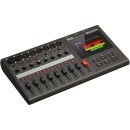
Zoom R20 |
VS | |
|---|---|---|
| Desktop | Form Factor | Desktop |
| WAV: 8 |
Number of Tracks | 12 (10 Inputs + Stereo Mix) |
| 8x Recording / 16x Playback (at 44.1 kHz) | Maximum Simultaneous Tracks | 10x Recording |
| 4.3" Color LCD Touchscreen | Display | - |
| 44.1 kHz / 24-Bit | Maximum Sampling Rate | 48 kHz / 24-Bit |
| 8 | Number of Microphone Inputs | - |
| Built-In Microphone | - | |
| 8x Knob | Input Level Adjustment | - |
| 1x Master | Number of Headphone Mixes | - |
| Sample Pads | - | |
